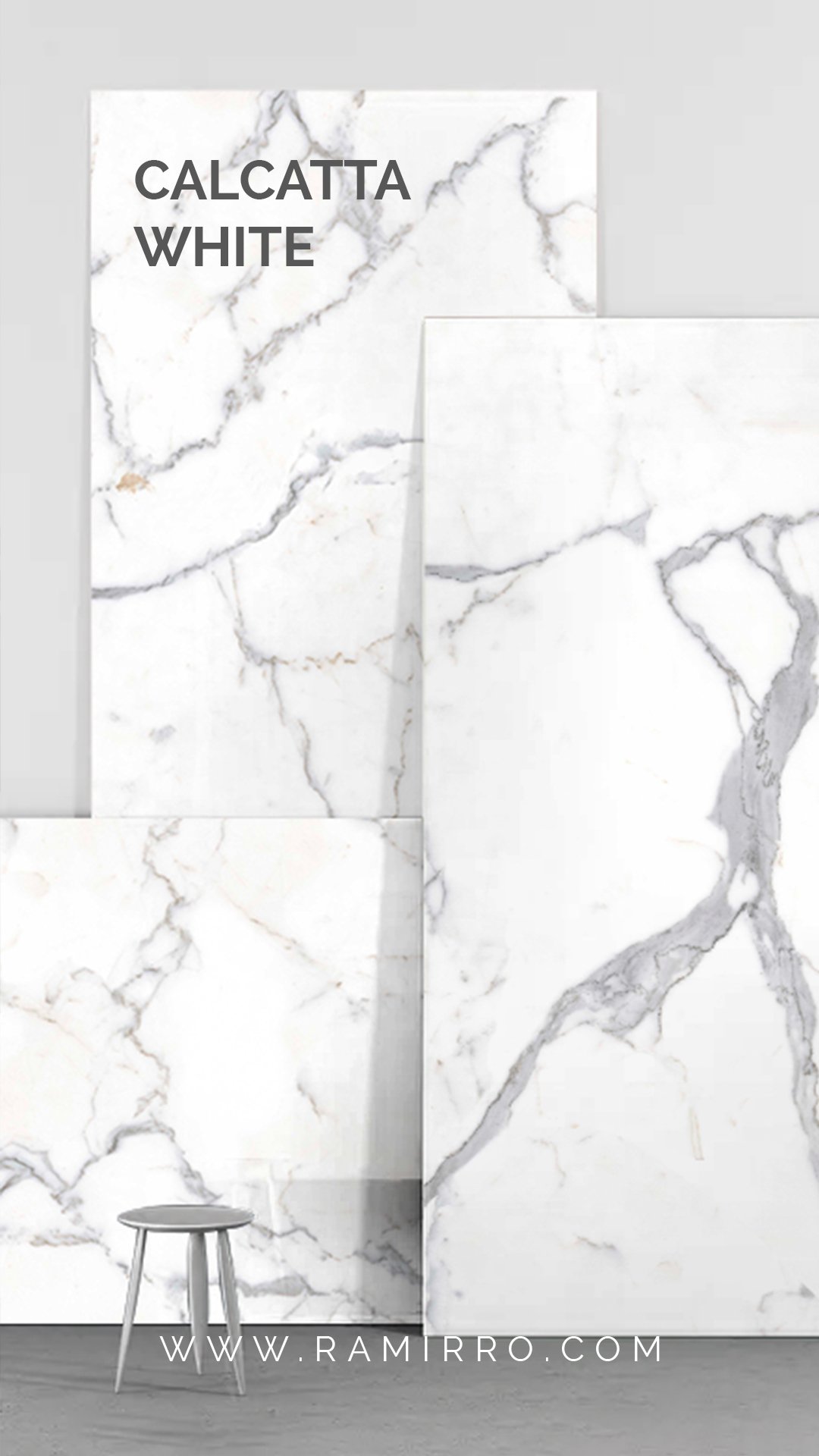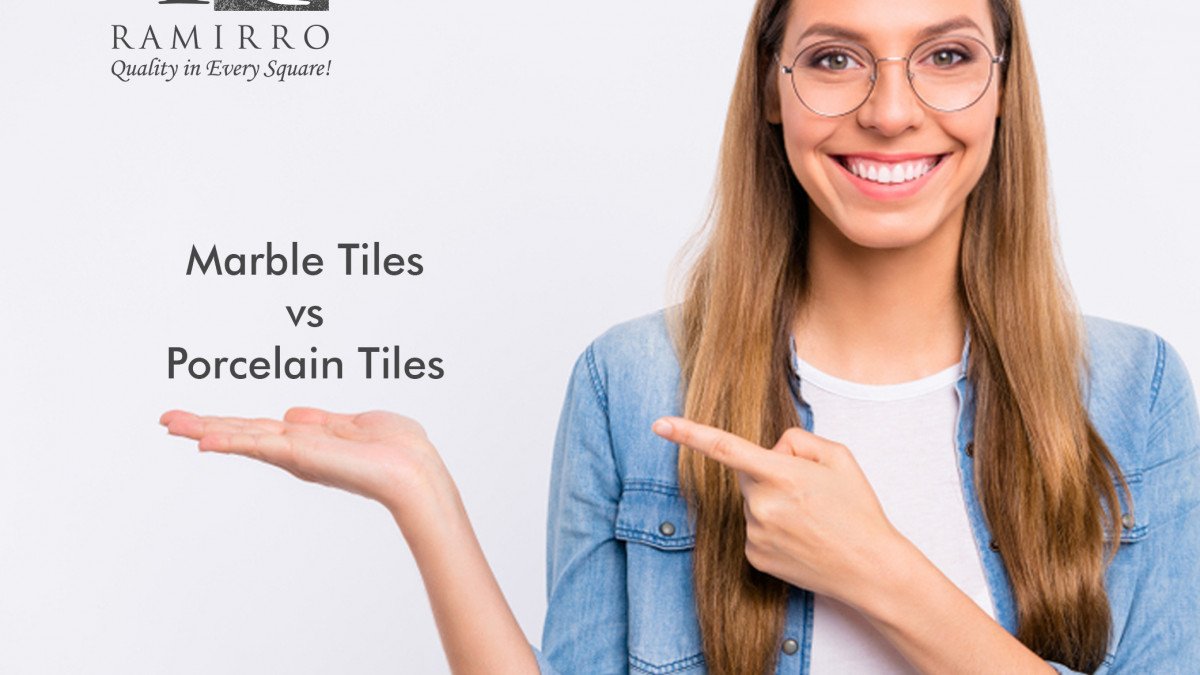Marble vs Porcelain Tiles: The Ultimate Comparison Guide

Best Pastel Tiles Color Collection: Create a Relaxing and Refreshing Space!
February 3, 2023
Marble vs Porcelain Countertops: Which is Better for You?
February 4, 2023When it comes to flooring and countertops, two popular options are marble and porcelain tiles. While both materials have their own unique benefits, it can be difficult to determine which one is the best fit for your home. In this comparison guide, we’ll take a closer look at marble and porcelain tiles to help you make an informed decision.
Why Should You Trust us?
Here’s what you get out of our article. Our team have various Ceramic Experts with experience of more than 25 Years, researches on problems our customer faces in tiling industry.
Ramirro Ceramica, – One of The Leading Tiles Manufacturer and Supplier globally, helps you people gain knowledgeable insight before making your purchase decision for products related to the floor and wall tiles.
So, we have closely monitored all kinds of trends in the ceramic tiles manufacturing world, from the old days of clay and plain color to modern digital, realistic-looking designs printed on ceramics with high-depth effects.
Our tiling Experts have seen thousands of different tiles patterns, sizes, materials, pricing, and installation techniques throughout their career.
Their expertise shared with you in simplified and organised way, helps you choose and make better decision before purchasing any flooring option available in market.
Brief about Company:
Ramirro is one of the finest Tiles manufacturers in India manufacturing porcelain and ceramic tiles. Our products have a variety of sizes and types of tiles ranging from Ceramics, porcelain, Full body etc. This helps you choose the perfect fit for your project. Plus, our collection will help you get inspiration from the architect’s design.
Here’s some more helpful links that showcase our users trust on Ramirro Ceramica Brand:
– Growth in International Market
– Trusted and Licensed Exporter
– Manufacturing Plant in India
Here’s our social proof by LinkedIn competing with top known global tiling brands:

Difference between Marble and Porcelain Tiles?
| Porcelain Tiles | Marble Tiles | |
| How they look in real life |  |  |
| Definition | Man-made tiles | Natural occurring Material |
| Appearance & Styling Options | Unlimited Design – Customisation available | Limited Styling option |
| Thickness | 8 mm to 18 mm | 10 mm average thickness |
| Raw Materials | Clay, Feldspar, Quartz and more. | Natural occurring Calcite |
| Manufacturing Process | Gets baked into kiln after mixing raw material | Marble block get trimmed into slabs |
| Sizes | Variety of Sizes avaliable larger than marble slab | Average marble slab is 2400x1200mm |
| Uses | Living Room, Bed Room, Kitchen, etc. | Living Room, Bed Room, Kitchen, etc. |
| Durability | – Flexible & long lasting | – Hard & long lasting |
| Installation | – Requires Tiling Expert | – Requires marble expert |
| Maintenance | – Zero to Minimum Maintenance cost | – Polishing might be required after every few year |
| Cleaning | – Easy to Clean with Soap | – Stains might be harder to clean if left for longer period of time. |
| Price | $-$$ | $$-$$$ |
| Pros | – Low Price – Easy to clean – Stain Proof – Chemically Inert – Fireproof – Scratch Resistance – Durable | – Easy to clean – Fireproof – Scratch Resistance – Durable – Resale value |
| Cons | – Cold surface | – Expensive – Maintenance |
| Highest Quality Tiles Source from | India, Italy, Spain Etc. | [Calcutta, SATUARIO, CARRARA – Italy], Indian Marble, Etc. |
| Shop | Shop Online at Ramirro Ceramica | You can visit mining & marble processing companies |
Definition
What is Porcelain Tiles?
Porcelain tiles are a type of ceramic tile that are made from high-density, fine-grain clay and are fired at extremely high temperatures. This process results in tiles that are extremely hard and durable, making them ideal for use in high-traffic areas.
What is marble Tiles?
Marble tiles are a type of natural stone tile made from large blocks of solid marble. Marble is a metamorphic rock formed by the heat and pressure alteration of limestone or dolomite. The minerals within the limestone or dolomite recrystallize over time, forming the interlocking crystals that comprise marble.
Depending on the minerals present in the original limestone or dolomite and the conditions under which it was altered, this process can take millions of years and result in a wide range of colours and patterns. The resulting marble is prized for its beauty, durability, and versatility, making it a popular choice in the construction and home design industries.
Appearance & Styling option
Porcelain Tiles
Porcelain tiles have a variety of appearance and styling options, making them a popular choice for both homeowners and designers. Among the key appearance and styling options are:
Colors and finishes: Porcelain tiles come in a variety of colours, including solids, patterns, and textures. Matte, glossy, and textured finishes are all popular.
Porcelain tiles are available in a variety of sizes, ranging from small mosaic tiles to large format tiles that can be used to create a sleek and modern look. Porcelain tiles are also available in a variety of shapes, including square, rectangular, hexagonal, and others.
Decorative Pieces: To add a unique touch to any design, porcelain tiles can be used to create decorative pieces such as borders, medallions, and accent pieces.
Porcelain tiles can be printed to look like a variety of natural materials, including marble, wood, and stone. These tiles have the appearance of natural materials without the maintenance and upkeep that the real thing requires.
Marble Tiles
Patterns of Veining
One of the most distinguishing characteristics of marble is its distinct veining pattern. Marble veins can be subtle and understated or bold and dramatic, and they come in a variety of colours, including white, black, grey, and even blue.
Polished Surface
For marble tiles, a polished finish is a popular choice. It imparts a glossy, smooth surface to the tiles, enhancing the natural beauty of the marble while also making it easier to clean and maintain.
Honed Surface
A honed finish is a smooth, matte surface created by grinding down the marble until it is flat and even. Because it is less slippery than a polished finish, this type of finish is ideal for high-traffic areas.
Tumbled Surface
Tumbling the marble tiles in a drum with small stones and other materials results in a tumbled finish. This gives the tiles a worn, weathered appearance, which adds character and warmth to a room.
Thickness, Size
Porcelain Tiles
Porcelain or Vitrified Tiles sizes
Sizes in mm (millimeters):
– Small Size: 300*600, 600*600, 600*1200, 800*800
– Heavy duty parking tiles (Porcelain Vitrified): 300*300, 400*400, 600×600
– Porcelain Slab Big Sizes (Porcelain Vitrified): 800*1600, 1200*1200, 1000*1000, 1200×1800, 900*1800, 1200×2400
– Wooden Strips (Porcelain Vitrified): 200*1200, 200*1000
– Step & Riser (Porcelain Vitrified): 200*900, 300*900, 200*1000, 300*1000
– Porcelain Slab Big Sizes (Porcelain Vitrified): 800*1600, 1200*1200, 1000*1000, 1200×1800, 900*1800, 1200×2400
Thickness: Various from 6mm to 18mm
Color: Multiple colors
Area: Wall and Floors
Tiles Manufacturing Company: Ramirro Ceramica
Ceramic tiles sizes
Sizes in mm(millimeters): 200*300, 250*375, 250*750, 300*450, 300*600, 200*600, 300×900, 300*300, 369*396 (400*400), 500*500, 600*600, 100*300, 200*200, 75*300, 100*200, 150*150.
Thickness: Various from 6mm to 18mm
Color: Multiple colors
Area: Wall and Floors
Tiles Manufacturing Company: Ramirro Ceramica
Full Body Tiles sizes
Sizes in mm(millimeters): 300×300, 600×600, 600×1200, 800×1600
Thickness: Various from 6mm to 18mm
Color: Multiple colors
Area: Wall and Floors
Tiles Manufacturing Company: Ramirro Ceramica
Color Body Tiles Sizes for floor and Wall Tiles [Large Size available]
Sizes in mm(millimeters): 800×2400: 800×3000: 800×3200, 1200×2400, 1200×3000, 1200×3200, 1200×1600, 1600×3200
Thickness: Various from 6mm to 18mm
Color: Multiple colors
Area: Wall and Floors
Tiles Manufacturing Company: Ramirro Ceramic
Marble Tiles
General size are 3.30X2.00 metres, whereas the Paonazzo and Paonazzetto’s type of marble are normally 2.40-2.50X1.20-1.40 metres.
Manufacturing Process
Porcelain Tiles
Porcelain tiles are a popular choice for flooring and wall cladding because they are long-lasting, resistant to water, and come in a variety of styles and finishes. The production of porcelain tiles begins with the selection of raw materials. The base material is typically composed of clays, feldspar, kaolin, and other minerals.
After selecting the raw materials, they are ground into a fine powder and mixed with water to form a dense slurry. This slurry is then poured into a mould and pressed and shaped to the desired shape. The moulded tiles are then dried to remove any remaining moisture, which usually takes several days.
After drying, the tiles are fired at high temperatures to make them more durable and resistant to moisture. The firing process also aids in the fusion of the materials, resulting in a solid, dense tile. The temperature used during firing varies depending on the type of porcelain tile being manufactured, with some tiles being fired at temperatures exceeding 1000 degrees Celsius.
The porcelain tiles are glazed and polished after firing to give them a smooth, shiny finish. This glazing process also protects the tiles from stains and scratches, increasing their durability and longevity.
Finally, the porcelain tiles are inspected for quality before being packaged and shipped to customers. From the selection of raw materials to the final inspection and shipping of the finished product, the entire process of manufacturing porcelain tiles typically takes several weeks.
Marble Tiles
Because of their natural beauty and durability, marble tiles are a popular choice for flooring, countertops, and walls. The extraction of raw marble blocks from quarries is the first step in the manufacturing process of marble tiles. The raw blocks are then transported to the manufacturing facility, where they are processed through several stages before becoming finished marble tiles.
Slicing and shaping
The raw marble blocks are cut into slabs of the desired thickness as the first step in the manufacturing process. A gang saw, which is a large machine with multiple blades, is typically used to cut through the marble blocks. After the slabs are cut, they are shaped and polished using a bridge saw or a water jet to the desired size and shape.
Polishing and grinding
Following the shaping and cutting of the slabs, the surface is ground and polished to achieve a smooth and uniform finish. This is accomplished through the use of a series of progressively finer abrasive tools, beginning with a rough grit and ending with a fine grit. The surface is buffed to a high shine during the polishing process, which highlights the natural beauty of the marble and gives it a smooth and luxurious feel.
Durability
Marble Tiles Vs Porcelain tiles
When it comes to durability, porcelain tiles are the clear winner. Made from a dense and durable clay, porcelain tiles are resistant to scratches, chips, and cracks, making them a popular choice for high-traffic areas like the kitchen and bathroom. On the other hand, marble is a softer stone that is more susceptible to scratches and chips. It is also prone to staining if not properly sealed, making it a less practical choice for high-traffic areas.
Installation
Porcelain Tiles vs Marble tiles
Marble tiles are typically larger and heavier than porcelain tiles, so they require a solid and stable substrate to be installed on. The most common substrates used are concrete or cementboard. If you have a wooden subfloor, you will need to first install a cementboard to provide a stable base for the tiles.
Porcelain tiles are much lighter and smaller than marble tiles, so they can be installed on a variety of substrates, including concrete, cementboard, and wooden subfloors. Unlike marble tiles, porcelain tiles can also be installed over existing tile or other flooring materials.
Both marble and porcelain tiles have their own unique features and benefits, and choosing between them will depend on a variety of factors. When it comes to the installation process, marble tiles are more complicated and require a higher level of skill and experience. Porcelain tiles, on the other hand, are much easier to install and can often be done by a DIY enthusiast. Regardless of which tile you choose, it is always recommended to hire a professional for the job to ensure that it is done correctly.
To read more on installation process- checkout How to install tiles
Maintenance & Cleaning
Porcelain Tiles vs Marble Tiles
When it comes to maintenance, porcelain tiles are also the more practical choice. They are easy to clean and maintain, requiring only occasional mopping or wiping with a damp cloth. Marble, on the other hand, requires regular sealing and polishing to keep its surface free from stains and scratches. This can be time-consuming and costly, especially if you have a large surface area of marble.
Price
Porcelain Tiles vs Marble Tiles – Pricing Cost!
When it comes to cost, marble and porcelain tiles can vary greatly in price. Marble is typically more expensive than porcelain tiles, due to the cost of extracting and processing the stone. Porcelain tiles, on the other hand, are typically more affordable, making them a more budget-friendly option for homeowners.
Conclusion
When choosing between marble and porcelain tiles, there are several factors to consider, including durability, maintenance, cost, and aesthetics. Ultimately, the best choice will depend on your specific needs and preferences. If you are looking for a low-maintenance and budget-friendly option, porcelain tiles may be the way to go. If you are willing to put in the time and effort to maintain a luxurious and elegant look, marble may be the right choice for you. Ramirro Ceramica is known for delivering high quality Made in India Tiles at affordable rate. They have 5000+ designs to choose from including Calcutta Marble designs with gold veins in porcelain collection. Shop now – View Catalogue





